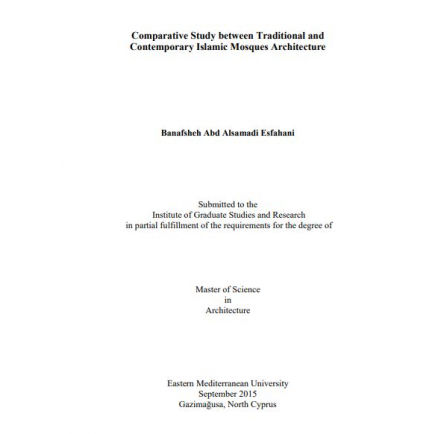
Comparative Study between Traditional and Contemporary Islamic Mosques Architecture
Date Added
04/07/2022
Content Type
Dissertation
Category
Masters
Link to Content
Subject Area
Mosques
Author
Banafsheh Abd Alsamadi Esfahani
Publisher Name
Eastern Mediterranean University
Year of Publication
2015
Description
The fundamental objective of Islamic architecture is creating space to meet Muslims’
spiritual and to some extent non-spiritual demands. Actually, mosques are physical
places and their existence formed by Muslims’ interrelationship with physical
environment. According to this points of view mosque plays an important role in
Muslims religious community through the link between its physical realities and their
beliefs. Presence of the mosque is the most complex, sensitive and controversial
issues that its tremendous architectural design is known as symbol of the Islamic
architects’ design ability. In fact, mosques and their fundamental components leads
to individuals going from non-spiritual to spiritual space and they must provide both
visual and spiritual aspects. The architectural characteristics of the mosques have
involved various transformation from the beginning which has been ‘Muhammad
Prophet ‘Mosque up to our contemporary world. Through ages, mosques’
architecture has resulted in a shift from ancient to new development. The secular
aspect of contemporary life created new movement in mosques’ architectural form as
tool to generate new conceptual design. Although these transformations tries to link
the traditional mosque to contemporary ones and mapping their similarities and
differences but created gaps by faded away spiritual space in mosque architectural
space rather than past. The aim of the research tries to investigate what are the causes
of these gaps in the differences between traditional and contemporary mosque
architecture. This thesis will focus on the role of Muslims religious beliefs on space
spirituality in both traditional and contemporary mosques. The study have been
limited to Jameh mosques type in the cities of Tehran, Isfahan, Shiraz and Domghan
in Iran and Istanbul and Ankara in Turkey and the totally nine mosques have been chosen in both periods. According to mosques types analysis in terms of decline and
intensity of religious beliefs in reaching spiritual space by considering general
characteristic of the mosque architecture, comparison of these characteristic in both
traditional and contemporary periods and literature review methodologies based on
observation technique findings revels that the basic reasons derive from deviation of
Muslims religious beliefs from the past and modern technologies. Consequentially,
mosque as a most important factor in city structure becomes faded and its role in the
organization of Islamic city space is ignored.
Files
English
traditional and contemporary mosques, mosque architectural characteristics , traditional mosques types, space spirituality, Muslims religious belief.
Banafsheh Abd Alsamadi EsfahaniBanafsheh Abd Alsamadi Esfahani
Eastern Mediterranean Universit
2015





